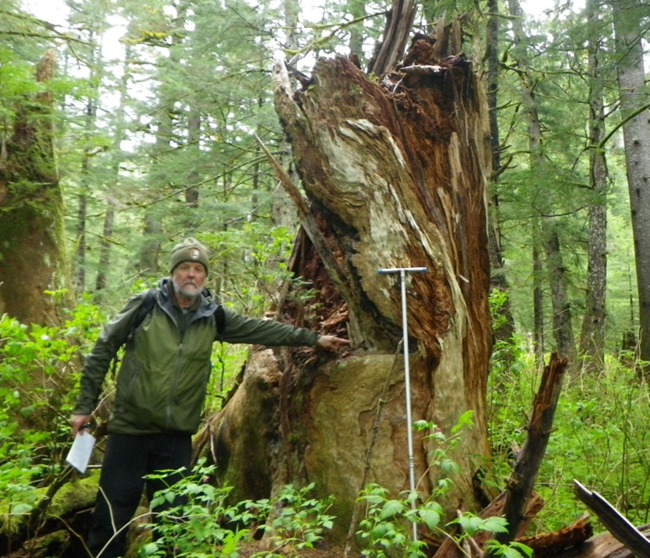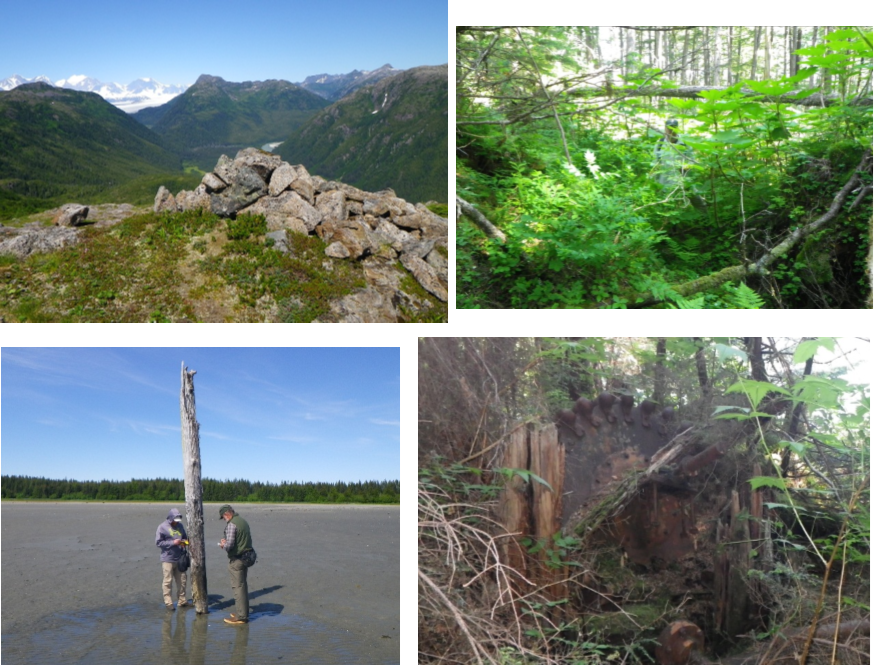Last updated: February 16, 2018
Article
Searching for Clues to Human History on the Glacier Bay Landscape
By Wayne Howell, Brian Choate,Weston Bacon-Schulte (all National Park Service)
What kinds of archeological sites are found in the park? How many sites have been located?
Project Dates
May 1, 2013—Sept. 3, 2015

Dendrochronology can be used to determine the approximate year that the tree was bark-stripped.
Introduction
In 1963 archeologist Robert Ackerman of Washington State University began a 3-year archeological survey of Glacier Bay National Monument. In this first attempt to understand Glacier Bay’s rich and diverse human history, 48 sites were documented within monument boundaries. Subsequent surveys brought the number to 90. The National Park Service, as steward of these irreplaceable cultural resources, recognizes a responsibility to revisit these sites, assess their condition and improve their level of documentation. Thus, 50 years after Ackerman, a new 3-year archeological survey began.
The project consists of re-visiting known sites and also surveying large areas of the park with archeological potential that have never been inventoried. The potential exists for many more sites to be discovered, including some of national significance. The researchers are particularly excited about surveying the outer coast where sites dating to the human colonization of the New World might be located. This study dovetails with a geological research project intended to reconstruct the ancient shoreline of Glacier Bay’s outer coast.
The team is attempting to document culturally modified trees (CMTs) before they are lost to death and decay. Some of these trees may have been bark-stripped as many as 250 years ago by Tlingit people to acquire food, fire starter, and craft or construction materials. CMTs may be important as site indicators since they tend to be located in places that would have been attractive to prehistoric as well as historic peoples. Thus there is a sense of urgency to record them before they are lost.

Clockwise from top left: Why did native people make rock piles on mountaintops hundreds of years ago? In 2013 the archeologists located 63 of these mysterious cairns on the mountains above Dundas Bay. The cairns can possibly be dated by analyzing the lichens and mosses growing on them. Finding archeological sites in the Southeast Alaska rainforest is a daunting task. Archeologists must become skilled in detecting subtle clues in vegetation and landforms. This waterwheel powered Kane’s sawmill in Excursion Inlet in the 1940s. The mill was probably associated with war-time activities. Brian and Wayne make notes and take a GPS reading on a piling that was part of a fish trap at Point Gustavus. Although located within the boundaries of Glacier Bay National Monument, this trap was operational in the early 1950s.
Methods and Findings
The archaeologists travel to known or high-potential study areas by skiff or kayak and set up a base camp. They venture out each day to locate previously recorded sites, and from there conduct surveys to search for undocumented sites in the general area. All sites that are at least 50 years old are documented with a GPS location, a sketch map to scale, photographs, and narrative descriptions. In some cases, the archeologists work closely with the geologists investigating shoreline and sea level changes.
In the 2013 field season the archeologists recorded 47 new sites spanning the past 250 years, bringing to 137 the total number of documented sites in the park. The team located and mapped 347 CMTs and re-visited 38 previously-recorded sites. They also discovered an intriguing landform in Excursion Inlet. The landform, radiocarbon-dated to 13,390 years ago, will be investigated further for cultural evidence next season.
